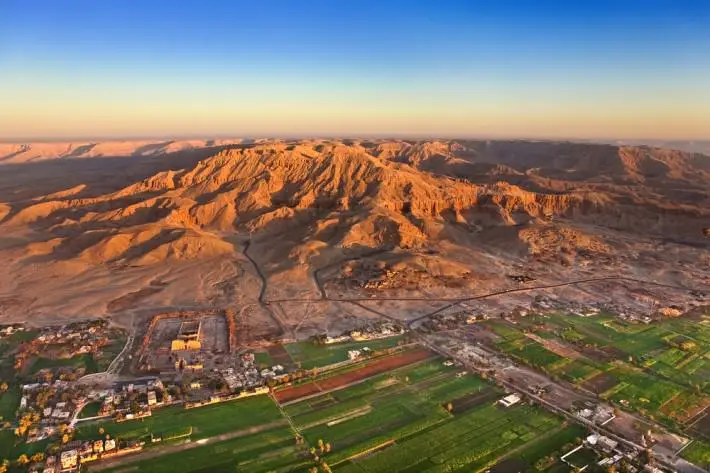Cultural, historical, adventure, and custom customized trips are just a few of the tours that Deluxe trips offer in Egypt and Jordan.

No place in Egypt's ancient past is as captivating as the West Bank of Luxor. Located on the western bank of the Nile River, opposite modern Luxor city, it is a vast outdoor museum that offers a tour of the splendor of ancient Thebes, the Egyptian capital during the New Kingdom period.West Bank is famous for its ancient mortuary temples, royal burial grounds, and ruins dating back hundreds of years, a site which tourists would desire to see to experience the spirit of ancient Egypt. Why Is the West Bank in Luxor So Important? In ancient Egyptian culture, the west — where the setting sun came to rest — was the place of the dead. It therefore became the final resting places for pharaohs, queens, nobility, and workers who built the opulence of Thebes. The Luxor West Bank has some of the planet's most renowned archaeological sites, such as:Valley of the Kings, Temple of Queen Hatshepsut, Colossi of Memnon, Valley of the Queens, Medinet Habu, Tombs of the Nobles, Deir el-Medina (Workers' Village)
1. Valley of the Kings – The Royal Necropolis
Perhaps the jewel in the crown of the West Bank is the Valley of the Kings, in which over 60 tombs of New Kingdom pharaohs have been discovered. Among them is the celebrated Tomb of Tutankhamun, whose desecrated burial chamber was uncovered by Howard Carter in 1922 largely intact. All tombs in the valley are overlaid with hieroglyphic scripts and colorful murals depicting the pharaoh's path to the afterlife. The splendor of the tombs testifies to the creative brilliance and religious devotion of ancient Egyptian society. The absolute must-see tombs: KV62: Tomb of Tutankhamun KV17: Tomb of Seti I (one of the most richly decorated) KV9: Tomb of Ramses V and VI
2. Temple of Queen Hatshepsut – A Monument of Power and Legacy
Rising from the desert hills at Deir el-Bahari, Queen Hatshepsut's Mortuary Temple is among Egypt's most architecturally stunning temples. Senenmut, her royal architect, created this temple as a celebration of Egypt's first great female pharaoh. Its tiered structure blends seamlessly with the mountains in the background, symbolizing harmony between nature and human efforts.
3. Colossi of Memnon – Guards of the Past
Standing 18 meters tall, the Colossi of Memnon are two massive stone statues of Pharaoh Amenhotep III. They were once part of an enormous mortuary temple, which now remains mostly in ruins. Though they have been weathered by time and plundered by nature, they still awe visitors with their size and ancient mystery.
4. Valley of the Queens – The Eternal Homes of Royal Women
The Valley of the Queens holds the tombs of royal wives and offspring. The pride here is the Tomb of Queen Nefertari, wife of Ramses II, renowned for its rich, excellently preserved wall paintings demonstrating her status as royalty and the devotion of her husband.
5. Deir el-Medina – The Village of Artisans
This old worker's village was where the builders of the royal tombs lived. Deir el-Medina offers a view of daily life for ordinary people during Egypt's New Kingdom. Their tombs, although smaller, bear richly colored paintings and personal remarks.
6. Medinet Habu – The Temple of Ramses III
Less crowded than most of the other temples, Medinet Habu is a temple and fortified complex. Colorful reliefs inside show the victories of Pharaoh Ramses III against the Sea Peoples, economic accounts, and ceremonial representations.
Be there early Tours will generally start with the sunrise to avoid the heat. Wear comfortable shoes: You will have been walking extensively on sand and stone. Pack water, sunblock, and a hat. Hire a guide: Most tombs and temples have fascinating stories that are easily overlooked without an expert Egyptologist. Photos are banned in certain tombs: Make sure to check restrictions beforehand. Getting There Most tourists come over by taking a motorboat or ferry ride from the East Bank, then take a private guide or go on a day tour. Day tours usually consist of air-conditioned transportation, lunch, and admission tickets. West Bank Day Tours Most tour operators offer Luxor West Bank Day Trips and combine several top attractions into one package. This is suitable for time-constrained travelers but would like to see as much as they can.
Some top tour packages include: Valley of the Kings + Hatshepsut Temple + Colossi of Memnon West Bank + East Bank (Karnak & Luxor Temples) Full Luxor Day Tour with hot air balloon experience.
Final Thoughts: Why You Shouldn't Miss Luxor's West Bank
The Luxor West Bank isn't a bunch of ruins – it's a window into the minds and religion of one of the more advanced civilizations in the history of humanity. From giant pharaohs to working craftsmen, their stories are etched into stone to be unveiled to you.
Regardless if you are a history enthusiast, a culture seeker, or a traveler attracted to grand landscapes, Luxor's West Bank will leave you speechless.
Discover now our answers to the most common questions that may come to your mind about tourism and trips to Egypt
Cultural, historical, adventure, and custom customized trips are just a few of the tours that Deluxe trips offer in Egypt and Jordan.
The Dead Sea, Petra in Jordan, the Pyramids of Giza, Luxor's historic temples, and many other famous sites can be expected to be explored with Deluxe Tours.
offer a hassle-free holiday, Deluxe Tours' packages generally include lodging, transport, meals, guided tours with experienced local experts, and entry fees to attractions.
Spring (March to May) and fall (September to November) offer the finest weather for sightseeing and outdoor activities, making those months the best times to visit Egypt and Jordan.
These two countries are close by, only a 1.5-hour flight apart, and when combined, offer a variety of distinctive experiences. We advise you to spend at least 12 days visiting both countries for a truly unforgettable experience
Combining the eclipse viewing with visits to historic sites like the Pyramids of Giza, the Valley of the Kings, and a Nile River cruise are highly recommended.
